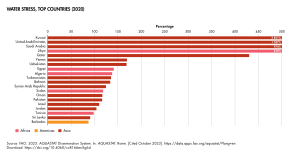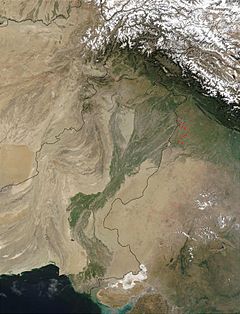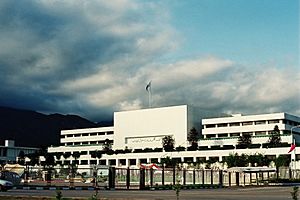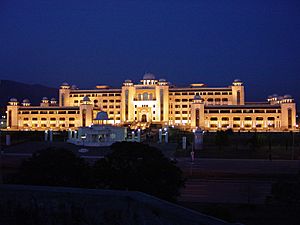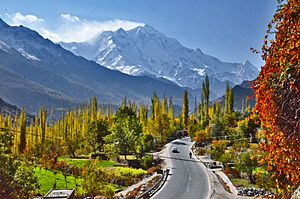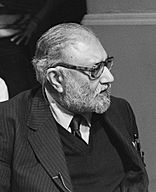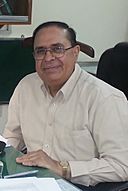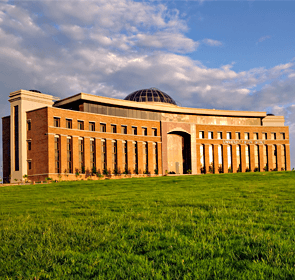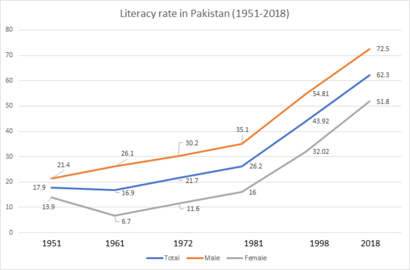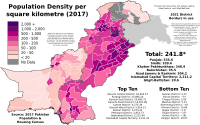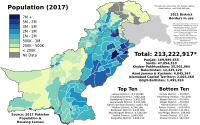Pakistan facts for kids
Quick facts for kids
Islamic Republic of Pakistan
|
|
|---|---|
|
Motto: Īmān, Ittihād, Nazam
ایمان، اتحاد، نظم "Faith, Unity, Discipline" |
|
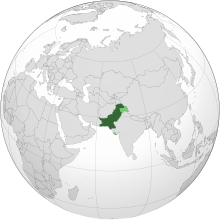
Land controlled by Pakistan shown in dark green; land claimed but not controlled shown in light green
|
|
| Capital | Islamabad 33°41′30″N 73°03′00″E / 33.69167°N 73.05000°E |
| Largest city | Karachi 24°51′36″N 67°00′36″E / 24.86000°N 67.01000°E |
| Official languages | |
| Native languages | Over 77 languages |
| Ethnic groups | See below |
| Religion |
|
| Demonym(s) | Pakistani |
| Government | Federal Islamic parliamentary republic |
| Arif Alvi | |
| Shehbaz Sharif | |
| Sadiq Sanjrani | |
| Legislature | Parliament |
| Senate | |
| National Assembly | |
| Independence
from the United Kingdom
|
|
| 23 March 1940 | |
| 14 August 1947 | |
|
• Republic
|
23 March 1956 |
|
• Last territory's acquisition
|
8 December 1958 |
|
• Eastern territory withdrawn
|
16 December 1971 |
| 14 August 1973 | |
| Area | |
|
• Total
|
881,913 km2 (340,509 sq mi) (33rd) |
|
• Water (%)
|
2.86 |
| Population | |
|
• 2023 census
|
241,499,431 (5th) |
|
• Density
|
273.8/km2 (709.1/sq mi) (56th) |
| GDP (PPP) | 2023 estimate |
|
• Total
|
|
|
• Per capita
|
|
| GDP (nominal) | 2023 estimate |
|
• Total
|
|
|
• Per capita
|
|
| Gini (2018) | ▼ 31.6 medium |
| HDI (2022) | low · 161st |
| Currency | Pakistani rupee (₨) (PKR) |
| Time zone | UTC+05:00 (PKT) |
| DST is not observed | |
| Date format |
|
| Driving side | left |
| Calling code | +92 |
| ISO 3166 code | PK |
| Internet TLD | |
Pakistan, officially the Islamic Republic of Pakistan, is a country in South Asia. It is the fifth-most populous country, with a population of over 241.5 million, having the second largest Muslim population as of 2023. Islamabad is the nation's capital, while Karachi is its largest city and financial centre. Pakistan is the 33rd-largest country by area, being the second largest in South Asia. Bounded by the Arabian Sea on the south, the Gulf of Oman on the southwest, and the Sir Creek on the southeast, it shares land borders with India to the east; Afghanistan to the west; Iran to the southwest; and China to the northeast. It shares a maritime border with Oman in the Gulf of Oman, and is separated from Tajikistan in the northwest by Afghanistan's narrow Wakhan Corridor.
Pakistan is the site of several ancient cultures, including the 8,500-year-old Neolithic site of Mehrgarh in Balochistan, the Indus Valley civilisation of the Bronze Age, and the ancient Gandhara civilisation. The regions that comprise the modern state of Pakistan were the realm of multiple empires and dynasties, including the Achaemenid, the Maurya, the Kushan, the Gupta; the Umayyad Caliphate in its southern regions, the Samma, the Hindu Shahis, the Shah Miris, the Ghaznavids, the Delhi Sultanate, the Mughals, and most recently, the British Raj from 1858 to 1947.
Pakistan is considered a middle power nation, with the world's sixth-largest standing armed forces. It is a declared nuclear-weapons state, and is ranked amongst the emerging and growth-leading economies, with a large and rapidly-growing middle class. Pakistan is a member of the United Nations, the Shanghai Cooperation Organisation, the Organisation of Islamic Cooperation, the Commonwealth of Nations, the South Asian Association for Regional Cooperation, and the Islamic Military Counter-Terrorism Coalition, and is designated as a major non-NATO ally by the United States.
Contents
Etymology
The name Pakistan was coined by Choudhry Rahmat Ali, a Pakistan Movement activist, who in January 1933 first published it (originally as "Pakstan") in a pamphlet Now or Never, using it as an acronym. Rahmat Ali explained: "It is composed of letters taken from the names of all our homelands, Indian and Asian, Panjab, Afghania, Kashmir, Sindh, and Baluchistan." He added, "Pakistan is both a Persian and Urdu word... It means the land of the Paks, the spiritually pure and clean." Etymologists note that پاک pāk, is 'pure' in Persian and Pashto and the Persian suffix ـستان -stan means 'land' or 'place of'.
Rahmat Ali's concept of Pakistan only related to the north-west area of the Indian subcontinent. He also proposed the name "Banglastan" for the Muslim areas of Bengal and "Osmanistan" for Hyderabad State, as well as a political federation between the three.
Name, Flag and Anthem of Pakistan
The name Pakistan (English pronunciation: or Urdu: پاکستان ) means Land of (the) Spiritually Pure in both Urdu and Persian languages. Many South-central Asian states and regions end with the element -stan, such as Afghanistan, Pakistan, Balochistan, Kurdistan, and Turkistan. This -stan is formed from the Iranian root *STA "to stand, stay," and means "place (where one stays), home, country". Iranian peoples have been the main inhabitants of the various land regions of the Ancient Persian Empires now owned by the states for over a thousand years. The names are compounds of -stan and the name of the peoples living there. Pakistan is a bit different; its name was coined on 28 January 1933 as Pakstan by Choudhary Rahmat Ali, a Pakistan Movement activist, who published it in his paper Now or Never. by using the suffix -istan from Balochistan preceded by the first letters of Punjab, Afghania, Kashmir and Sindh. The name is actually an acronym that stands for the "thirty million Muslim brethren who lived in Pakistan—by which we mean the Five Northern units of India viz: Punjab, (Afghan Province), Kashmir, Sind, and Baluchistan". The letter i was incorporated to ease pronunciation and forms the linguistically correct and meaningful name. Interestingly, a word almost the same in form, etymology, and meaning to the Iranian suffix -stan is found in Polish, which has a word stan meaning "state" (in the senses of both polity and condition). It can be found in the example of a Polish name for the "United States of America," Stany Zjednoczone Ameryki (literally "States United of America").
National Anthem
Music
The "Qaumī Tarānah" is a melodious and harmonious rendering of a three-stanza composition with a tune based on eastern music but arranged in such a manner that it can be easily played by foreign bands.
The music, composed by the Pakistani musician and composer, Ahmad G. Chagla in 1949, reflects his background in both eastern and western music. Typically twenty-one musical instruments and thirty-eight different tones are used to play the "Qaumi Taranah", the duration of which is usually around 80 seconds.
Lyrics
The lyrics, written by the Pakistani Urdu-language poet, Hafeez Jullundhri in 1952, have commonality with Persian, rendering them mutually intelligible in both Urdu and Persian languages. No verse in the three stanza lyrics is repeated. The lyrics have heavy Persian poetic vocabulary, and only uses one exclusively Urdu word 'kā'.
Flag
The flag is a green field with a white crescent moon and five-rayed star at its centre, and a vertical white stripe at the hoist side. Though the green colour is mandated only as 'dark green', its official and most consistent representation is Pakistan green, which is shaded distinctively darker.
The flag was designed by Syed Amir uddin Kedwaii and was based on the original flag of the Muslim League. It was adopted by the Constituent Assembly of Pakistan on August 11, 1947, just days before independence. The white colour on the flag represents the minorities and the green the Muslim majority. The crescent on the flag represents progress while the five-rayed star represents light and knowledge.
Geography, environment, and climate

Pakistan's diverse geography and climate host a wide array of wildlife. Covering 881,913 km2 (340,509 sq mi), Pakistan's size is comparable to France and the UK combined. It ranks as the 33rd-largest nation by total area, but this varies based on Kashmir's disputed status. Pakistan boasts a 1,046 km (650 mi) coastline along the Arabian Sea and the Gulf of Oman, and shares land borders totaling 6,774 km (4,209 mi), including 2,430 km (1,510 mi) with Afghanistan, 523 km (325 mi) with China, 2,912 km (1,809 mi) with India, and 909 km (565 mi) with Iran. It has a maritime border with Oman, and shares a border with Tajikistan via the Wakhan Corridor. Situated at the crossroads of South Asia, the Middle East, and Central Asia, Pakistan's location is geopolitically significant. Geologically, Pakistan straddles the Indus–Tsangpo Suture Zone and the Indian tectonic plate in Sindh and Punjab, while Balochistan and most of Khyber Pakhtunkhwa sit on the Eurasian plate, primarily on the Iranian plateau. Gilgit-Baltistan and Azad Kashmir, along the Indian plate's edge, are susceptible to powerful earthquakes.
Pakistan's landscapes vary from coastal plains to glaciated mountains, offering deserts, forests, hills, and plateaus. Pakistan is divided into three major geographic areas: the northern highlands, the Indus River plain, and the Balochistan Plateau. The northern highlands feature the Karakoram, Hindu Kush, and Pamir mountain ranges, hosting some of the world's highest peaks, including five of the fourteen eight-thousanders (mountain peaks over 8,000 metres or 26,250 feet), notably K2 (8,611 m or 28,251 ft) and Nanga Parbat (8,126 m or 26,660 ft). The Balochistan Plateau lies in the west and the Thar Desert in the east. The 1,609 km (1,000 mi) Indus River and its tributaries traverse the nation from Kashmir to the Arabian Sea, sustaining alluvial plains along the Punjab and Sindh regions.
The climate varies from tropical to temperate, with arid conditions in the coastal south. There is a monsoon season with frequent flooding due to heavy rainfall, and a dry season with significantly less rainfall or none at all. Pakistan experiences four distinct seasons: a cool, dry winter from December through February; a hot, dry spring from March through May; the summer rainy season, or southwest monsoon period, from June through September; and the retreating monsoon period of October and November. Rainfall varies greatly from year to year, with patterns of alternate flooding and drought common.
Flora and fauna
The diverse landscape and climate in Pakistan support a wide range of trees and plants. From coniferous alpine and subalpine trees like spruce, pine, and deodar cedar in the northern mountains to deciduous trees like shisham in the Sulaiman Mountains, and palms such as coconut and date in the southern regions. The western hills boast juniper, tamarisk, coarse grasses, and scrub plants. Mangrove forests dominate the coastal wetlands in the south. Coniferous forests span altitudes from 1,000 to 4,000 metres (3,300 to 13,100 feet) in most northern and northwestern highlands. In Balochistan's xeric regions, date palms and Ephedra are prevalent. In Punjab and Sindh's Indus plains, tropical and subtropical dry and moist broadleaf forests as well as tropical and xeric shrublands thrive. Approximately 2.2% or 1,687,000 hectares (16,870 km2) of Pakistan was forested in 2010.
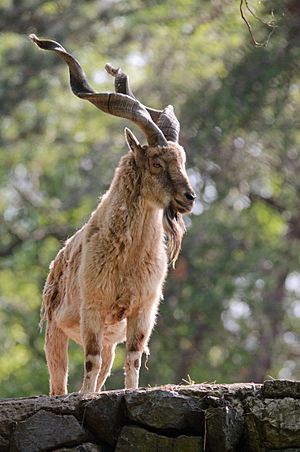
Pakistan's fauna mirrors its diverse climate. The country boasts around 668 bird species, including crows, sparrows, mynas, hawks, falcons, and eagles. Palas, Kohistan, is home to the western tragopan, with many migratory birds visiting from Europe, Central Asia, and India. The southern plains harbor mongooses, small Indian civet, hares, the Asiatic jackal, the Indian pangolin, the jungle cat, and the desert cat. Indus is home to mugger crocodiles, while surrounding areas host wild boars, deer, porcupines, and small rodents. Central Pakistan's sandy scrublands shelter Asiatic jackals, striped hyenas, wildcats, and leopards. The mountainous north hosts a variety of animals like the Marco Polo sheep, urial, markhor goat, ibex goat, Asian black bear, and Himalayan brown bear.
The lack of vegetative cover, severe climate, and grazing impact on deserts have endangered wild animals. The chinkara is the only animal found in significant numbers in Cholistan, with a few nilgai along the Pakistan–India border and in some parts of Cholistan. Rare animals include the snow leopard and the blind Indus river dolphin, of which there are believed to be about 1,100 remaining, protected at the Indus River Dolphin Reserve in Sindh. In total, 174 mammals, 177 reptiles, 22 amphibians, 198 freshwater fish species and 5,000 species of invertebrates (including insects) have been recorded in Pakistan. Pakistan faces deforestation, hunting, and pollution, with a 2019 Forest Landscape Integrity Index mean score of 7.42/10, ranking 41st globally out of 172 countries.
Government and politics
Pakistan operates as a democratic parliamentary federal republic, with Islam designated as the state religion. Initially adopting a constitution in 1956, Pakistan saw it suspended by Ayub Khan in 1958, replaced by a second constitution in 1962. A comprehensive constitution emerged in 1973, suspended by Zia-ul-Haq in 1977 but reinstated in 1985, shaping the country's governance. The military's influence in mainstream politics has been significant throughout Pakistan's history. The eras of 1958–1971, 1977–1988, and 1999–2008 witnessed military coups, leading to martial law and military leaders governing de facto as presidents. Presently, Pakistan operates a multi-party parliamentary system with distinct checks and balances among government branches. The first successful democratic transition occurred in May 2013. Pakistani politics revolves around a blend of socialism, conservatism, and the third way, with the three main political parties being the conservative Pakistan Muslim League-N, socialist PPP, and centrist PTI. Constitutional amendments in 2010 curtailed presidential powers, enhancing the role of the prime minister.
- Head of State: The ceremonial head of the state and civilian commander-in-chief of the Pakistan Armed Forces is the President, elected by an Electoral College. The Prime Minister appoints military personnel and key confirmations after reviewing merit and performance reports. Almost all judicature, military, and legislative appointments require executive confirmation, with the President holding powers to pardon and grant clemency.
- Legislative: The bicameral legislature includes a 104-member Senate (upper house) and a 342-member National Assembly (lower house). National Assembly members are elected via first-past-the-post under universal adult suffrage, representing National Assembly constituencies. The constitution reserves 70 seats for women and religious minorities, allocated to political parties based on proportional representation. Senate members are elected by provincial legislators, ensuring equal representation across all provinces.
- Executive: The Prime Minister, typically the leader of the majority rule party or coalition in the National Assembly (the lower house), serves as the country's chief executive and head of government. Responsibilities include forming a cabinet, making executive decisions, and appointing senior civil servants, subject to executive confirmation.
- Provincial governments: Each of the four provinces follows a similar governance system, with a directly elected Provincial Assembly choosing the Chief Minister, usually from the largest party or coalition. Chief Ministers lead the provincial cabinet and oversee provincial governance. The Chief Secretary, appointed by the Prime Minister, heads the provincial bureaucracy. Provincial assemblies legislate and approve the provincial budget, typically presented by the provincial finance minister annually. Ceremonial heads of provinces, the Provincial Governors, are appointed by the President.
- Judicature: The judiciary in Pakistan has two classes: the superior and subordinate judiciary. The Chief Justice of Pakistan oversees the court system at all levels. The superior judiciary includes the Supreme Court of Pakistan, Federal Shariat Court, and five high courts, with the Supreme Court at the top. It's responsible for safeguarding the constitution. Azad Kashmir and Gilgit-Baltistan have their own court systems.
Administrative divisions
| Administrative division | Capital | Population |
|---|---|---|
| Quetta | 12,344,408 | |
| Lahore | 110,126,285 | |
| Karachi | 47,886,051 | |
| Peshawar | 40,525,047 | |
| [[File:|22x20px|border |alt=|link=]] Gilgit-Baltistan | Gilgit | 1,800,000 |
| Muzaffarabad | 4,567,982 | |
| Islamabad Capital Territory | Islamabad | 2,851,868 |
A federal parliamentary republic state, Pakistan is a federation that comprises four provinces: Punjab, Khyber Pakhtunkhwa, Sindh and Balochistan, and three territories: Islamabad Capital Territory, Gilgit-Baltistan and Azad Kashmir. The Government of Pakistan exercises the de facto jurisdiction over the Frontier Regions and the western parts of the Kashmir Regions, which are organised into the separate political entities Azad Kashmir and Gilgit-Baltistan (formerly Northern Areas). In 2009, the constitutional assignment (the Gilgit–Baltistan Empowerment and Self-Governance Order) awarded the Gilgit-Baltistan a semi-provincial status, giving it self-government.
The local government system consists of a three-tier system of districts, tehsils, and union councils, with an elected body at each tier. There are about 130 districts altogether, of which Azad Kashmir has ten and Gilgit-Baltistan seven.
Law enforcement is carried out by a joint network of the intelligence community with jurisdiction limited to the relevant province or territory. The National Intelligence Directorate coordinates the information intelligence at both federal and provincial levels; including the FIA, IB, Motorway Police, and Civil Armed Forces such as the Pakistan Rangers and the Frontier Corps.
Pakistan's "premier" intelligence agency, the Inter-Services Intelligence (ISI), was formed just within a year after the Independence of Pakistan in 1947. ABC News Point in 2014 reported that the ISI was ranked as the top intelligence agency in the world.
The court system is organised as a hierarchy, with the Supreme Court at the apex, below which are high courts, Federal Shariat Courts (one in each province and one in the federal capital), district courts (one in each district), Judicial Magistrate Courts (in every town and city), Executive Magistrate Courts, and civil courts. The Penal code has limited jurisdiction in the Tribal Areas, where law is largely derived from tribal customs.
Human rights
Male homosexuality is illegal in Pakistan and punishable with up to life in prison. In its 2018 Press Freedom Index, Reporters Without Borders ranked Pakistan number 139 out of 180 countries based on freedom of the press. Television stations and newspapers are routinely shut down for publishing any reports critical of the government or the military.
Tourism
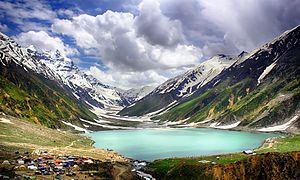
With its diverse cultures, people, and landscapes, Pakistan attracted around 6.6 million foreign tourists in 2018, which represented a significant decline since the 1970s when the country received unprecedented numbers of foreign tourists due to the popular Hippie trail. The trail attracted thousands of Europeans and Americans in the 1960s and 1970s who travelled via land through Turkey and Iran into India through Pakistan. Northern Pakistan is well-known for its scenic beauty and several highest peaks of the world. The main destinations of choice for these tourists were the Khyber Pass, Peshawar, Karachi, Lahore, Swat and Rawalpindi. The numbers following the trail declined after the Iranian Revolution and the Soviet–Afghan War.
Pakistan's tourist attractions range from the mangroves in the south to the Himalayan hill stations in the north-east. The country's tourist destinations range from the Buddhist ruins of Takht-i-Bahi and Taxila, to the 5,000-year-old cities of the Indus Valley civilization such as Mohenjo-daro and Harappa. Pakistan is home to several mountain peaks over 7,000 metres (23,000 feet). The northern part of Pakistan has many old fortresses, examples of ancient architecture, and the Hunza and Chitral valleys, home to the small pre-Islamic Kalasha community claiming descent from Alexander the Great. Pakistan's cultural capital, Lahore, contains many examples of Mughal architecture such as the Badshahi Masjid, the Shalimar Gardens, the Tomb of Jahangir, and the Lahore Fort.
In October 2006, just one year after the 2005 Kashmir earthquake, The Guardian released what it described as "The top five tourist sites in Pakistan" in order to help the country's tourism industry. The five sites included Taxila, Lahore, the Karakoram Highway, Karimabad, and Lake Saiful Muluk. To promote Pakistan's unique cultural heritage, the government organises various festivals throughout the year. In 2015, the World Economic Forum's Travel & Tourism Competitiveness Report ranked Pakistan 125 out of 141 countries.
Transport
Motorways
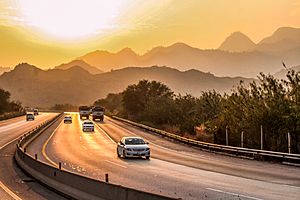
Motorways of Pakistan are a network of multiple-lane, high-speed, controlled-access highways in Pakistan, which are owned, maintained, and operated federally by Pakistan's National Highway Authority. As of 20 February 2020, 1882 km of motorways are operational, while an additional 1854 km are under construction or planned. All motorways in Pakistan are pre-fixed with the letter 'M' (for "Motorway") followed by the unique numerical designation of the specific highway (with a hyphen in the middle), e.g. "M-1".
Pakistan's motorways are an important part of Pakistan's "National Trade Corridor Project", which aims to link Pakistan's three Arabian Sea ports (Karachi Port, Port Bin Qasim and Gwadar Port) to the rest of the country through its national highways and motorways network and further north with Afghanistan, Central Asia and China. The project was planned in 1990. The China Pakistan Economic Corridor project aims to link Gwadar Port and Kashgar (China) using Pakistani motorways, national highways, and expressways.
Highways
Highways form the backbone of Pakistan's transport system; a total road length of 263,942 kilometres (164,006 miles) accounts for 92% of passengers and 96% of inland freight traffic. Road transport services are largely in the hands of the private sector. The National Highway Authority is responsible for the maintenance of national highways and motorways. The highway and motorway system depends mainly on north–south links connecting the southern ports to the populous provinces of Punjab and Khyber-Pakhtunkhwa. Although this network only accounts for 4.6% of total road length, it carries 85% of the country's traffic.
Railways
The Pakistan Railways, under the Ministry of Railways (MoR), operates the railroad system. From 1947 until the 1970s the train system was the primary means of transport until the nationwide constructions of the national highways and the economic boom of the automotive industry. Beginning in the 1990s there was a marked shift in traffic from rail to highways; dependence grew on roads after the introduction of vehicles in the country. Now the railway's share of inland traffic is below 8% for passengers and 4% for freight traffic. As personal transportation began to be dominated by the automobile, total rail track decreased from 8,775 kilometres (5,453 miles) in 1990–91 to 7,791 kilometres (4,841 miles) in 2011. Pakistan expects to use the rail service to boost foreign trade with China, Iran, and Turkey.
Airports
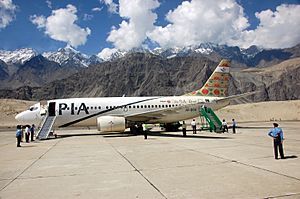
There are an estimated 151 airports and airfields in Pakistan as of 2013—including both the military and the mostly publicly owned civilian airports. Although Jinnah International Airport is the principal international gateway to Pakistan, the international airports in Lahore, Islamabad, Peshawar, Quetta, Faisalabad, Sialkot, and Multan also handle significant amounts of traffic.
The civil aviation industry is mixed with public and private sectors, which was deregulated in 1993. While the state-owned Pakistan International Airlines (PIA) is the major and dominant air carrier that carries about 73% of domestic passengers and all domestic freight, the private airlines such as airBlue and Air Indus, also provide similar services at a low cost.
Seaports
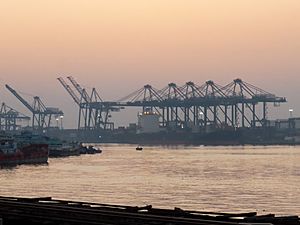
Major seaports are in Karachi, Sindh (the Karachi port, Port Qasim). Since the 1990s some seaport operations have been moved to Balochistan with the construction of Gwadar Port, Port of Pasni and Gadani Port. Gwadar Port is the deepest sea port of the world. According to the WEF's Global Competitiveness Report, quality ratings of Pakistan's port infrastructure increased from 3.7 to 4.1 between 2007 and 2016.
Science and technology
Developments in science and technology have played an important role in Pakistan's infrastructure and helped the country connect to the rest of the world. Every year, scientists from around the world are invited by the Pakistan Academy of Sciences and the Pakistan Government to participate in the International Nathiagali Summer College on Physics. Pakistan hosted an international seminar on "Physics in Developing Countries" for the International Year of Physics 2005. The Pakistani theoretical physicist Abdus Salam won a Nobel Prize in Physics for his work on the electroweak interaction. Influential publications and critical scientific work in the advancement of mathematics, biology, economics, computer science, and genetics have been produced by Pakistani scientists at both the domestic and international levels.
In chemistry, Salimuzzaman Siddiqui was the first Pakistani scientist to bring the therapeutic constituents of the neem tree to the attention of natural products chemists. Pakistani neurosurgeon Ayub Ommaya invented the Ommaya reservoir, a system for treatment of brain tumours and other brain conditions. Scientific research and development play a pivotal role in Pakistani universities, government- sponsored national laboratories, science parks, and the industry. Abdul Qadeer Khan, regarded as the founder of the HEU-based gas-centrifuge uranium enrichment program for Pakistan's integrated atomic bomb project. He founded and established the Kahuta Research Laboratories (KRL) in 1976, serving as both its senior scientist and the Director-General until his retirement in 2001, and he was an early and vital figure in other science projects. Apart from participating in Pakistan's atomic bomb project, he made major contributions in molecular morphology, physical martensite, and its integrated applications in condensed and material physics.
In 2010 Pakistan was ranked 43rd in the world in terms of published scientific papers. The Pakistan Academy of Sciences, a strong scientific community, plays an influential and vital role in formulating recommendations regarding science policies for the government. Pakistan was ranked 88th in the Global Innovation Index in 2023, up from 107th in 2020.
The 1960s saw the emergence of an active space program led by SUPARCO that produced advances in domestic rocketry, electronics, and aeronomy. The space program recorded a few notable feats and achievements. The successful launch of its first rocket into space made Pakistan the first South Asian country to have achieved such a task. Successfully producing and launching the nation's first space satellite in 1990, Pakistan became the first Muslim country and second South Asian country to put a satellite into space.
Pakistan witnessed a fourfold increase in its scientific productivity in the past decade surging from approximately 2,000 articles per year in 2006 to more than 9,000 articles in 2015. Making Pakistan's cited article's higher than the BRIC countries put together.
Competition with India and tensions eventually led to Pakistan's decision to conduct underground nuclear tests in 1998, thus becoming the seventh country in the world to successfully develop nuclear weapons.
Pakistan is the first and only Muslim country that maintains an active research presence in Antarctica. Since 1991 Pakistan has maintained two summer research stations and one weather observatory on the continent and plans to open another full-fledged permanent base in Antarctica.
Energy consumption by computers and usage has grown since the 1990s when PCs were introduced; Pakistan has about 82 million Internet users and is ranked as one of the top countries that have registered a high growth rate in Internet penetration as of 2020[update]. Key publications have been produced by Pakistan, and domestic software development has gained considerable international praise.
As of May 2020, Pakistan has about 82 million internet users, making it the 9th-largest population of Internet users in the world. Since the 2000s Pakistan has made a significant amount of progress in supercomputing, and various institutions offer research opportunities in parallel computing. The Pakistan government reportedly spends ₨ 4.6 billion on information technology projects, with emphasis on e-government, human resources, and infrastructure development.
Education
The constitution of Pakistan requires the state to provide free primary and secondary education.
At the time of the establishment of Pakistan as a state, the country had only one university, Punjab University in Lahore. Very soon the Pakistan government established public universities in each of the four provinces, including Sindh University (1949), Peshawar University (1950), Karachi University (1953), and Balochistan University (1970). Pakistan has a large network of both public and private universities, which includes collaboration between the universities aimed at providing research and higher education opportunities in the country, although there is concern about the low quality of teaching in many of the newer schools. It is estimated that there are 3,193 technical and vocational institutions in Pakistan, and there are also madrassahs that provide free Islamic education and offer free board and lodging to students, who come mainly from the poorer strata of society. Strong public pressure and popular criticism over extremists' usage of madrassahs for recruitment, the Pakistan government has made repeated efforts to regulate and monitor the quality of education in the madrassahs.
Education in Pakistan is divided into six main levels: nursery (preparatory classes); primary (grades one through five); middle (grades six through eight); matriculation (grades nine and ten, leading to the secondary certificate); intermediate (grades eleven and twelve, leading to a higher secondary certificate); and university programmes leading to graduate and postgraduate degrees. There is a network of private schools that constitutes a parallel secondary education system based on a curriculum set and administered by the Cambridge International Examinations of the United Kingdom. Some students choose to take the O-level and A level exams conducted by the British Council. According to the International Schools Consultancy, Pakistan has 439 international schools.
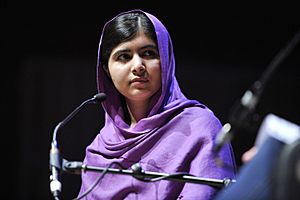
As a result of initiatives taken in 2007, the English medium education has been made compulsory in all schools across the country. In 2012, Malala Yousafzai, a campaigner for female education, was shot by a Taliban gunman in retaliation for her activism. Yousafzai went on to become the youngest ever Nobel laureate for her global education-related advocacy. Additional reforms enacted in 2013 required all educational institutions in Sindh to begin offering Chinese language courses, reflecting China's growing role as a superpower and its increasing influence in Pakistan. The literacy rate of the population is 62.3% as of 2018. The rate of male literacy is 72.5% while the rate of female literacy is 51.8%. Literacy rates vary by region and particularly by sex; as one example, in tribal areas female literacy is 9.5%, while Azad Jammu & Kashmir has a literacy rate of 74%. With the advent of computer literacy in 1995, the government launched a nationwide initiative in 1998 with the aim of eradicating illiteracy and providing a basic education to all children. Through various educational reforms, by 2015 the Ministry of Education expected to attain 100% enrollment levels among children of primary school age and a literacy rate of ~86% among people aged over 10. Pakistan is currently spending 2.3 percent of its GDP on education; which according to the Institute of Social and Policy Sciences is one of the lowest in South Asia.
Demographics
The Demographics of Pakistan are a study of the population and the people. It is estimated that Pakistan's population was over 170,000,000 in mid 2008. Pakistan had an estimated population of 169,300,000 as of July 2007,. Between 1951-1998, the number of people in Pakistan's cities and towns (known as the urban population) increased sevenfold. And by the next decade the population is expected to exceed 176 million. In the past, the country's population had a quite high growth rate. Dramatic social changes have led to rapid urbanisation and the emergence of megacities. Between 1990-2003, Pakistan sustained its historical lead as the most urbanised nation in South Asia, with city dwellers making up 34% of its population.
Pakistan has a multicultural and multi-ethnic society and has one of the largest refugee populations in the world as well as a young population.
Pakistan's next national census will take place in 2008.Ethnicity and languages
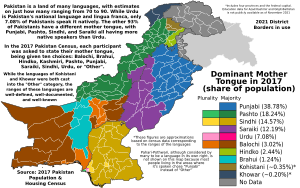
Pakistan is a multicultural, multi-linguistic, and multiethnic society. Despite Urdu being Pakistan's lingua franca, estimates on how many languages are spoken in the country range from 75 to 85, Urdu—the lingua franca and a symbol of Muslim identity and national unity—is the national language and understood by over 75% of Pakistanis. It is the main medium of communication in the country, but the primary language of only 7% of the population. Urdu and English are the official languages of Pakistan. English is primarily used in official business and government, and in legal contracts; the local variety is known as Pakistani English. The enforcement of Urdu to the exclusion of other majority languages has been criticised.
According to the 2017 national census of Pakistan, on the basis of languages, the country's largest ethnolinguistic groups were the Punjabis (making up 38.8% of the total population), the Pashtuns (18.2%), Sindhis (14.6%), Saraikis (12.19%), Muhajirs (7.08%), and the Balochs (3.02%). The remaining population consist of a number of ethnic minorities such as the Brahuis, the Hindkowans, the various peoples of Gilgit-Baltistan, the Kashmiris, the Sheedis (who are of African descent), and the Hazaras. There are also scattered speakers of Gujarati in Karachi.
There is also a large Pakistani diaspora worldwide, numbering over seven million, which has been recorded as the sixth largest diaspora in the world.
Largest cities
|
Largest cities or towns in Pakistan
According to the 2017 Census |
||
|---|---|---|
| Rank | Name | Pop. |
| 1 | Karachi | 14,916,456 |
| 2 | Lahore | 11,126,285 |
| 3 | Faisalabad | 3,204,726 |
| 4 | Rawalpindi | 2,098,231 |
| 5 | Gujranwala | 2,027,001 |
| 6 | Peshawar | 1,970,042 |
| 7 | Multan | 1,871,843 |
| 8 | Hyderabad | 1,734,309 |
| 9 | Islamabad | 1,009,832 |
| 10 | Quetta | 1,001,205 |
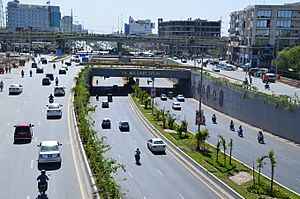
Religion
| Religions in Pakistan (2017 Census) | ||||
|---|---|---|---|---|
| Religions | Percent | |||
| Islam | 96.47% | |||
| Hinduism | 2.14% | |||
| Christianity | 1.27% | |||
| others/non-religious | 0.11% | |||
Islam is the state religion of Pakistan. Freedom of religion is guaranteed by the constitution, which provides all its citizens the right to profess, practice and propagate their religion subject to law, public order, and morality.
The majority of Pakistanis are Muslims (96.47%) followed by Hindus (2.14%) and Christians (1.27%). There are also smaller minorities who adhere to Sikhism, Buddhism, Jainism and Zoroastrianism (Parsi). The Kalash people maintain a unique identity and religion within Pakistan, practicing a form of animism and ancestor worship.
Hinduism is mostly associated with Sindhis, and Pakistan hosts major events such as the Hinglaj Yatra pilgrimage. Hindu temples may be found throughout Sindh, where the dharma features prominently. Many Hindus in Pakistan complain about the prospect of religious violence against them and being treated like second-class citizens, and many have emigrated to India or further abroad.
In addition, some Pakistanis also do not profess any faith (such as atheists and agnostics) in Pakistan. According to the 1998 census, people who did not state their religion accounted for 0.5% of the population.
Culture and society
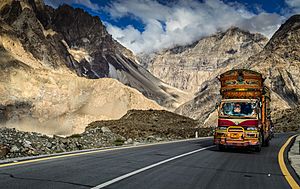
Food and drink
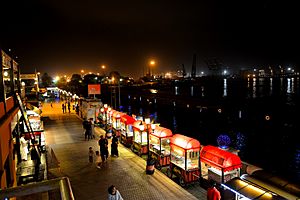
Traditional food
Pakistani cuisine is similar to that of other regions of South Asia, with some of it being originated from the royal kitchens of 16th-century Mughal emperors. Most of those dishes have their roots in British, Indian, Central Asian and Middle Eastern cuisine. Unlike Middle Eastern cuisine, Pakistani cooking uses large quantities of spices, herbs, and seasoning. Garlic, ginger, turmeric, red chili, and garam masala are used in most dishes, and home cooking regularly includes curry, roti, a thin flatbread made from wheat, is a staple food, usually served with curry, meat, vegetables, and lentils. Rice is also common; it is served plain, fried with spices, and in sweet dishes.
Lassi is a traditional drink in the Punjab region. Black tea with milk and sugar is popular throughout Pakistan and is consumed daily by most of the population. Sohan halwa is a popular sweet dish from the southern region of Punjab province and is enjoyed all over Pakistan.
Sports

In cricket, the country has had an array of success in the sport over the years, and has the distinct achievement of having won each of the major ICC international cricket tournaments: ICC Cricket World Cup, ICC World Twenty20, and ICC Champions Trophy; as well as the ICC Test Championship. Pakistan Super League is one of the largest cricket leagues of the world with a brand value of about Rs. 32.26 billion (US$110 million).
Football in Pakistan is as old as the country itself. Shortly after the creation of Pakistan in 1947, the Pakistan Football Federation was created, and Muhammad Ali Jinnah became its first Patron-in-Chief. Pakistan is known as one of the best manufactures of the official FIFA World Cup ball.
In field hockey, Pakistan is one of the most successful national teams with a record four Hockey World Cup wins, eight Asian Games gold medals, three gold medals in the Olympic Games, and the only Asian team to have won the prestigious Champions Trophy, with three championships.
Squash player Jahangir Khan is widely regarded as the greatest squash player of all time, followed by Jansher Khan. From 1981 to 1986, Jahangir was unbeaten and during that time won 555 consecutive matches – the longest winning streak by any athlete in top-level professional sport as recorded by Guinness World Records.
The annual Shandur Polo Festival in Northern Pakistan attracts international participants and is held at the world's highest polo ground.
Pakistan has hosted or co-hosted several international sporting events: the 1989 and 2004 South Asian Games; the 1984, 1993, 1996 and 2003 World Squash Championships; the 1987 and 1996 Cricket World Cup; and the 1990 Hockey World Cup. Pakistan is set to host the 2023 South Asian Games, the 2023 Asia Cup, and the 2025 ICC Champions Trophy.
See also
 In Spanish: Pakistán para niños
In Spanish: Pakistán para niños
- Outline of Pakistan
- Administrative divisions of Pakistan




